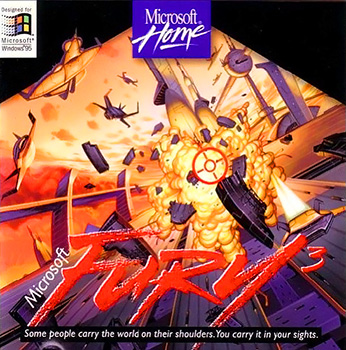Microsoft Fury³
Does anyone remember the Microsoft Home software suite? I remember the brand first surfacing shortly after we had purchased our first PC, loaded with Windows 95. It essentially boiled down to a collection of educational, productivity, and entertainment programmes, typically with an emphasis towards younger users. Microsoft Encarta (now all but a distant memory) was originally released under this sub-title, as was the very first Microsoft Flight Simulator. There was also another, flight-focused, game released around the same time that has left an enduring impression on me – Microsoft Fury³.
If the game itself sounds completely unfamiliar, then there’s a good chance that it’s developers – Terminal Reality – will evoke the same feelings. Some of their most recently released titles include the two BloodRayne games, Kinect Star Wars and Ghostbusters: The Video Game, titles that have been received, critically and commercially, rather lukewarmly. Back in 1995, however, the developers had already released their first commercial title on DOS, Terminal Velocity, in the same year as Fury3, so firm expectations had yet to be formulated in what direction the developers would take next.
This direction, as became apparent, seemed be very fixed, as Fury³ would appear to bear many similarities to Terminal Velocity, in gameplay terms and setting. I have never played this game, so cannot comment on the veracity of this view, but this would explain the very short space of time between both games release (a very paltry 3 months, in game development time).
None of this can be easily discerned by just playing Fury³ in its entirety, as its setting, story and gameplay appears to be very polished. Set within futuristic, sci-fi setting, players assume the role of a Councillor for a race known as the Terrans. This human-esque race were responsible for creating a new type of soldier during a conflict known as the IP Wars – the Bions. With the war over, the Bions become too powerful for the Terrans to control and, following an attempt to purge them completely, they retreat to the planet Fury³ in order to plan their attack against their creators. The Terrans next move is simplistically Machiavellian: send the Councillor to attack and destroy the Bions. In order to achieve this, the player follow’s a fairly linear course through 8 distinct planets in their journey towards Fury3 with diverse locales inspired by Earth, Mars, underwater and even ancient Egypt, ready to be explored. A huge arsenal of weaponry can be unleashed against the Bion forces and players are given the freedom to either complete the set objectives, or explore each stage for hidden bonuses or secret tunnels.
Each world has three stages, typically with at least one boss for each world. Whilst the bosses themselves appear diverse and different, the procedures for successfully defeating them – disable each one of their shield generators and then shooting the living bejesus out of them – does became somewhat repetitive as you work your way through the game. So to do mission objectives, which typically involve the destruction of set targets and successfully manoeuvring to a checkpoint. The game perhaps could of benefitted from a more diverse set of objectives, to better complement the continually diverse environments that the player comes across.
Some considerable effort has gone into the game’s backstory and setting, with intelligence reports at the start of each world providing the necessary flavour and detail to add towards the experience. The in-game cinematic’s as well, for the time, were also pretty impressive. This was back when any 3D game was a wonder to behold, irrespective of how primitive or basic it looked. As a young child, growing up on a healthy diet of 2D platforming games, to bear witness to such a glorious vision of the future of video gaming on the PC was enough to take me to even higher levels of infantile excitement.
This was also one of the first games on Windows that I remember having joypad and joystick support. Being able to play the game with a joystick (Microsoft recommends the Microsoft SideWinder range of controllers for optimal user experience!) was something of a novelty and really helped to increase the immersion factor. This was an edge that the PC had for a long-time over the conventional home consoles, in that there was support for a diverse range of different input devices for gaming. Nintendo and others attempted to try and emulate this, by realising controllers such as the Super Scope, but it strikes me that these never had the desired impact. This was either due to the cost of the devices themselves, or the very limited library of games that the device would support.
As I have been writing this, and replaying it for the purposes of this review, conflicting views have begun to enter my head: whereas I have incredibly fond memories of playing this game and completing it, playing it today does not hold quite the same magic as I would have expected it to. This is probably due to some of the reasons I have already highlighted: linearity, repetitiveness and, for those who may have played Terminal Velocity, a feeling of ‘been there, done that’. I wouldn’t go so far as to say that the game is absolutely terrible by a modern perspective, but would not place the game high on the list of most-recommended games for Windows 95. If you can somehow track down a copy of the game and manage to successfully run it on a newer operating system, then there is perhaps some fun to be had with this now largely obscure title. So long as you like tunnels. Lots of tunnels.
